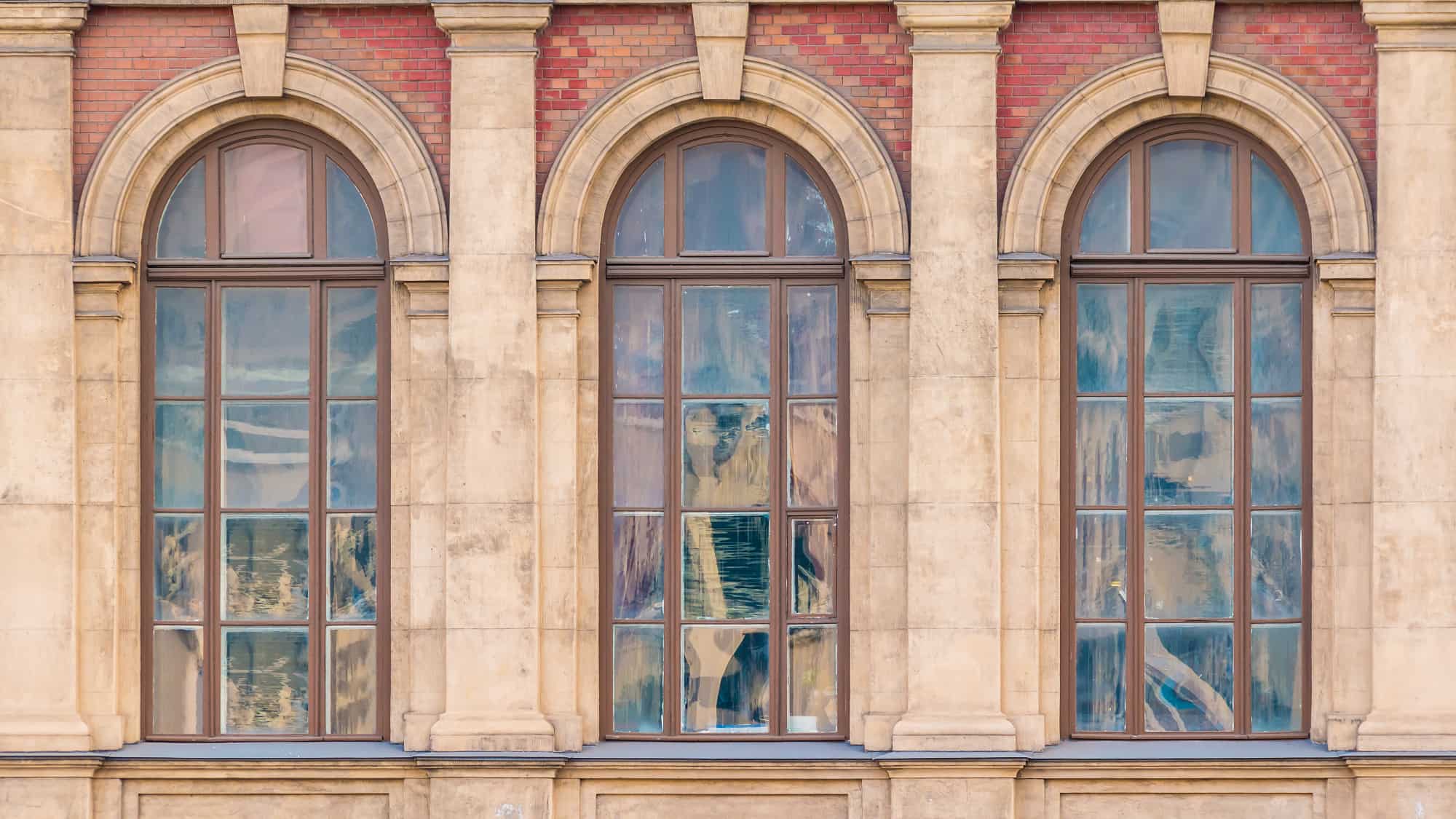When people talk about why they love historic buildings, certain features tend to come up again and again. Distinctive masonry. Intricate trim. Beautiful materials rarely present in modern architecture. But one of the most beloved features of these buildings is their windows. That is part of why window restoration is best for historic buildings. But there are also other significant reasons to retain rather than replace.
The Generosity (and Problems) of Old Windows
In “The Patience of Ordinary Things”, Pat Schneider wrote, “What is more generous than a window?” While the poem was meant to honor domestic everyday experiences with the materials around us all, the windows of historic buildings tend to be particularly generous. The old-growth wood, the wavy leaded glass, and the unique feel give them a distinct role in the overall architectural character and the occupant experience.
Despite this, “old windows” have become a term many building owners fear due to the potential cost of repair as materials deteriorate. Many are also concerned about energy efficiency for both environmental and financial reasons. As a result, it is common to wonder if window repair and restoration is worth it, or if replacement is a better option. As Sally Zimmerman, senior preservation services manager at Historic New England, says:
Most old windows have not been well cared for, so we think of them as troublesome. The simplicity with which you can replace them is very appealing: It’s the quick fix.
It is true that old windows, like all materials, are vulnerable to wear and tear. Wood frames are susceptible to the effects of temperature and humidity changes, leading to rot, cracks, and warping over time. Hardware rusts, joints fail, rope frays, movement becomes less fluid. It is also true that single-pane glass is not as energy-efficient as modern double-pane windows. However, these are usually obstacles that can be overcome or whose importance is overstated.
Why Is Window Restoration Best for Historic Buildings?
So if old windows are known to present challenges like the need for repair and suboptimal efficiency, doesn’t it make sense to just replace them? Probably not.
Many of the problems associated with old windows are not indications that old windows are inherently inferior to new windows. In fact, window restoration can have significant advantages for historic buildings:
Quality
Old windows were typically built with higher quality, old-growth wood that is superior to any modern option, making them more resilient; that’s why they’ve lasted so long in the first place. Restoring these windows can extend their life for decades to come.
Environmental Impact
While the increased efficiency of new windows may make them seem like the environmentally-friendly choice, manufacturing and transporting these windows uses considerable resources—particularly if lack of longevity means frequent replacement. In comparison, window restoration has a far smaller carbon footprint. As architect Mathew Cummins explains, “People replace 200-year-old windows with new vinyl ones that are guaranteed for five years. They are made of oil products and evil gases and soon their useful life is over and they end up in the landfill. Old windows are made of clean wood and glass, and, once rebuilt, are good for another 200 years. Never, never, never throw away old windows.”
Cost
There’s no way around it: restoring windows in historic buildings can be costly. However, the cost of replacing windows is usually even greater. This is especially true in the long term, as modern windows are more complex and have more points of failure, including the potential to trap moisture that damages wood and fogging. Over time, repair costs may end up being far greater than with original windows, which are generally more simple to repair, and you may have to replace new windows much sooner.
Value
Preserving original features and materials as much as possible has immense value in historic buildings. Replacing windows with new alternatives can compromise the aesthetic integrity of your property, decreasing its historic, cultural, and even economic worth. “Removing original windows inevitably destroys the character of a historic [building],” says Scott Sidler, a historic restoration specialist. “New windows were designed for new [buildings]. And while there are companies that make windows that look like historic ones, they are still not quite right. Lacking this major architectural element almost guarantees a lower resale price.”
Additionally, properly maintained old windows are usually not a major source of energy inefficiency in commercial historic buildings, despite not being as efficient as modern double-pane windows. As a result, recouping the cost of replacement via energy savings may take many years—or not happen at all. Repairing or adjusting frames and adding weather stripping can increase efficiency of original windows, but if you are concerned about energy efficiency, there are many other variables to consider aside from windows.

Window restoration can breathe new life into historic buildings while preserving their character.
Adhering to Regulations
There is another reason why window restoration is best for historic buildings: in many places, it’s required. In San Francisco, the historic building standards that regulated properties listed in the National Register of Historic Places and other registers stipulate that original windows should be retained whenever possible. In order to replace windows, you must apply for a permit and demonstrate that replacement is necessary based on specific performance issues, such as water penetration, energy performance, and air filtration. Due to historic preservation initiatives and public interest in preserving historic properties, the burden of proof can be significant.
If replacement is deemed necessary, any windows that are visible from the street must be replaced in kind. This means replacement windows must match the materials of the original windows, and cheap alternatives like vinyl windows cannot be used. As a result, replacement is often much more expensive and restrictive than many building owners anticipate.
However, restrictions don’t mean that you should put off dealing with window problems. Not only can poorly-maintained or damaged windows detract from the beauty of historic buildings, they also can cause occupant discomfort, decrease energy efficiency, and damage building materials. Additionally, they can pose a risk to public safety. In San Francisco, the Building Facade Inspection and Maintenance Ordinance requires that all elements of historic building facades are inspected and properly maintained in order to prevent injuries or death from facade deterioration, movement, and leaks. This makes proper window maintenance not just an issue of aesthetics, practicality, and ethics, but of the law.
Rainbow: A Window Restoration Expert
Rainbow is the San Francisco Bay Area’s premier expert in full-service window restoration and repair. With years of experience working on San Francisco’s beloved historic buildings, like the Pioneer Building, our team of experts understands both the value and challenges of your building’s original windows and can help you determine whether restoration is the right choice. If you do choose restoration, we stay true to the character of your original windows while making them safe, functional, and beautiful for years to come.
Let Rainbow show you why window restoration is best for historic buildings in the San Francisco Bay Area. Reach out to the Rainbow team today.

The Rainbow Team is Northern California’s most trusted waterproofing and restoration company. We have the craftsmanship and expertise to handle any commercial or historic building envelope, masonry, or waterproofing project in the San Francisco Bay Area.




